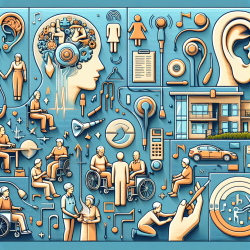The importance of aural rehabilitation in extended care facilities cannot be overstated, especially considering the high incidence of hearing impairment among the elderly population. A study conducted by B. Purves & B. Brooks offers valuable insights into two strategies aimed at improving the quality of life for residents with hearing loss. This blog post explores these strategies and provides practical advice for practitioners looking to implement these findings in their own settings.
Hearing Aid Maintenance and Registration Program
The first strategy focused on establishing a hearing aid maintenance and registration program. The program aimed to ensure that hearing aids were in good working condition and used properly by residents. Key components of the program included:
- Identifying residents with hearing aids and ensuring their devices were in good repair.
- Creating a registration system for hearing aids to track their use and maintenance.
- Providing earmold cleaning kits and training staff on hearing aid care.
Results showed an initial increase in hearing aid use, although some attrition was noted over time. This highlights the need for ongoing support and possibly the integration of family involvement in the care of hearing aids.
Training Staff on Communication Strategies
The second part of the study focused on enhancing staff's communication skills with hearing-impaired residents through a training videotape. The videotape covered effective communication strategies, such as ensuring proper lighting, reducing background noise, and speaking at a normal volume. After viewing the videotape, staff members demonstrated a significant increase in the use of these strategies.
This approach underscores the importance of educating care staff on how to interact with hearing-impaired individuals. Improving communication skills can have immediate and long-term benefits, increasing staff confidence and supporting more effective use of hearing aids.
Implementing the Strategies
Practitioners looking to implement these strategies should consider the following steps:
- Assess the current status of hearing aid use and care among residents.
- Develop a hearing aid maintenance and registration program tailored to the facility's needs.
- Provide training and resources to staff on hearing aid care and effective communication strategies.
- Engage family members in the care process where possible.
- Monitor and adjust the program based on feedback and results.
These strategies, though focused on a specific setting, offer broader implications for the care of hearing-impaired individuals in various extended care environments. By improving hearing aid maintenance and enhancing communication skills, we can significantly improve the quality of life for those with hearing impairments.
To delve deeper into the research and its findings, please follow this link: Two Strategies for Aural Rehabilitation in an Extended Care Facility.










